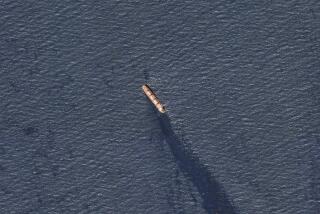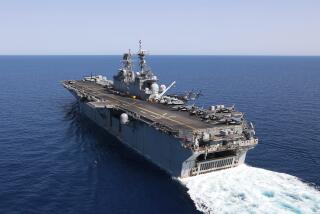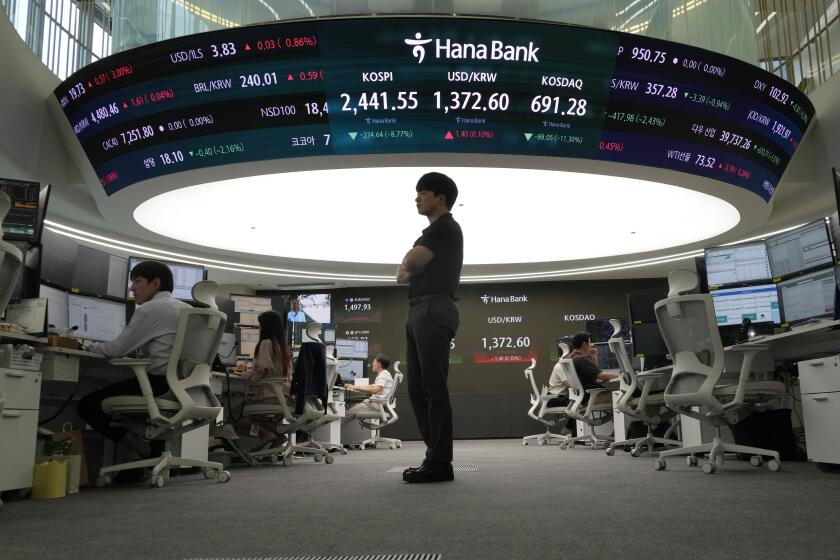Threat From Oil Pollution Adds to Woes for States in War-Torn Persian Gulf Area
MANAMA, Bahrain — The oil that made the Persian Gulf rich is fouling it.
Environmental experts say oil pollution has never been worse, and although they regard it as an indirect result of the 7 1/2-year-old war between Iraq and Iran, the actual source remains unknown.
“Nobody can do anything until the war is stopped, because it is too difficult to find the sources of the leakage,” said a government official of this island state.
Iran, however, has reported what it called an “unprecedented” oil slick in the Strait of Hormuz in the southern gulf and said it resulted from an Iraqi air raid on the Larak offshore oil terminal in the area.
The Islamic Republic News Agency quoted an official of Iran’s environmental protection organization as saying that thousands of fish have died and that the livelihood of local fishermen is endangered.
Walt Vreeland, an American adviser to the Bahrain-based Environmental Protection Committee, said the war restricts scouting of the gulf for signs of oil pollution.
“We’re very limited as to how far we can go out,” said Vreeland, a native of Bucks County, Pa. “Bahrain’s territorial waters are 12 miles, and to be quite honest about it, I’m not going to go 50 miles in a helicopter. No way.”
Vreeland said in an interview that Bahrain, which is about halfway up the 600-mile-long gulf, is among the hardest-hit areas, at a time when it is trying to attract tourists to its beaches.
‘It’s a Mess Down There’
“The main thing you’ll find are aesthetic problems. People just don’t want to go to the beach because it’s a mess down there,” Vreeland added. “The other indirect effects would be reduction of fish, of sea-grass beds. These are not areas you would expect to see immediate effects.”
Cleanup efforts already are under way on Bahrain’s beaches, but the oil remains in the water.
“I could see tar and tar balls all around. And when I saw the windsurfing boards, they had all turned black from the tar,” said a foreign resident, Ikuko Waki.
Oil pollution is not new to the gulf, where wells on shore and underwater produce nearly a fifth of the industrial world’s petroleum. In the past, however, the gulf could handle the occasional oil spill.
Extremely shallow along the coasts and about 300 feet at its deepest, the gulf is fed from the north by the Tigris and Euphrates rivers.
Naturally recycled every two years, the water flows out through the Strait of Hormuz, a passage so narrow as to prevent a large volume of water exchange between the gulf and the Arabian Sea.
“You have to realize we’re dealing with an oil spill of unknown source, of unknown size, of unknown duration,” said Vreeland. “We don’t know where it’s coming from, we don’t know how much is coming in. It’s very widespread.”
Heavy Pollution
Observers say more clumps of oil are floating in the southern gulf than at any time in the last year. Gulf-based shipping executives believe some is from three Iranian oil platforms wrecked by the U.S. Navy in reprisal attacks this spring. Vreeland says it isn’t known if they are leaking oil.
Another suspected source is Iran’s big Kharg Island oil terminal in the northern gulf. It has been attacked by Iraqi planes several times, but Iran has never reported on damage.
The Bahraini official says pollution threatens a commercial fishing industry, already affected by the war. South-flowing currents help keep northern waters clean, but “fishermen are afraid to go there” because of the fighting, he said.
Vreeland said that even after the disappearance of light fractions of the oil, which are most toxic to marine life, the heavy residue collects dirt and debris and sinks to the seabed, affecting some sea life.
As scientists analyze oil samples in a search for the source, public concern is growing.
More to Read
Sign up for Essential California
The most important California stories and recommendations in your inbox every morning.
You may occasionally receive promotional content from the Los Angeles Times.










